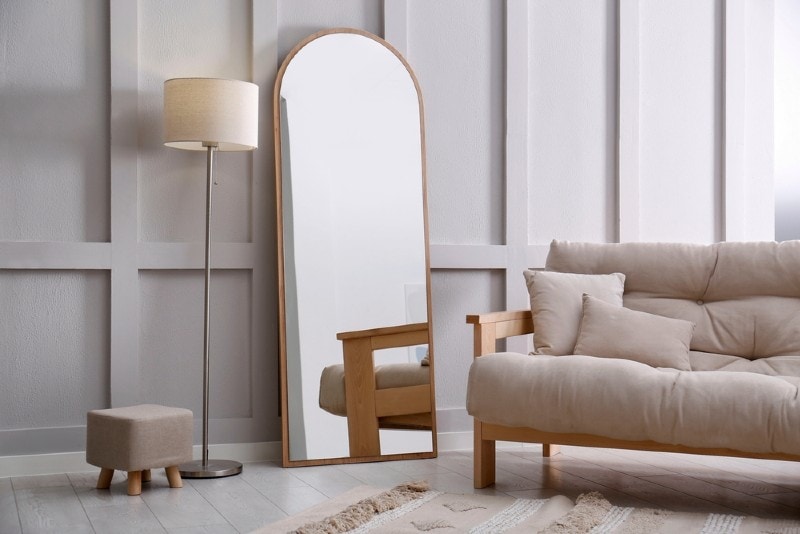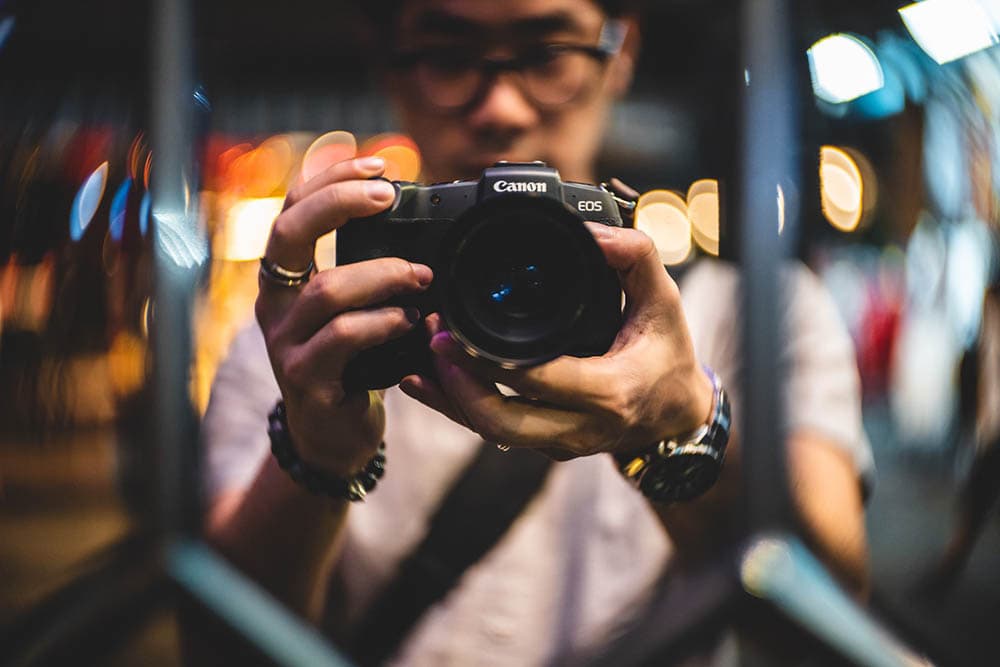How to Photograph a Mirror: Easy Tips & Tricks to Help You Master It!
Last Updated on

Anyone who has seen the movie The Ring knows the problem with taking a picture of a mirror. As the protagonist watches the home video, she realizes that a clip taken straight in front of a mirror lacks the photographer. Pretty spooky, right?
Although this scene in The Ring is meant to point out the supernatural nature of the at-home clip, there are ways that you can photograph a camera-less, head-on mirror shot without any supernatural abilities. You just have to know the right tips and tricks.
Below, learn how to take a photograph of a mirror with a clean finish.

The Problem with Photographing a Mirror
Mirrors and items with reflective surfaces are some of the most difficult objects to photograph. Because of the reflective surface, it can feel impossible to take a photo of the item without the camera or photographer being seen in the item’s reflection.
Thanks to modern technology ingenuity, there are ways that you can photograph a mirror head-on without the camera being seen.

Use a Tilt-Lens Camera
The best way to photograph a mirror head-on is to use a tilt-lens camera. Tilt-lens cameras work by changing the lens position as it relates to the camera’s image sensor. This tilt means that you can alter the plane of focus. In the case of a mirror picture, you can take a picture of the mirror without the camera being visible.
All you have to do is step slightly out of range, adjust the tilt-lens focus, and shoot. Edit yourself out of the picture later on. It’s as simple as that.
How to Use a Tilt-Lens Camera for Mirror Pictures
- Adjust the shift so that it focuses on your target image.
- Make sure the camera is horizontal.
- Step outside the frame of the mirror.
- Take the shot.
- Edit yourself out of frame later.
The Downside of the Tilt-Lens Camera
The tilt-lens camera is not perfect for all mirror shots. Most notably, it is ideal if you want to shoot a mirror reflection but do not need the entire mirror and its frame in the picture. With the tilt-lens camera, you will still appear in the mirror, but you can edit yourself out to showcase your selected item as the focal point of the image.

How to Photograph a Mirror without a Fancy Camera
If you do not have a tilt-lens camera, there’s another way that you can take a picture of a mirror head-on. This option allows the final picture to include the entire mirror and frame. As such, this method may be better if you need to sell a picture frame or for some other purpose.
With this method, you will have the mirror reflect a whiteboard. Cut a hole in this whiteboard and photograph the mirror from this hole. After the pictures are taken, Photoshop this hole out of the picture so that the mirror has a completely white reflection.

What You’ll Need
- Tools for cutting (the exact tool will depend on the material of the board0
- Whiteboard
- Editing software
How to Use White Board for Mirror Pictures
Begin by getting a thick white, board. White paper can work, but it needs to be thick enough so that it creates an entirely white backdrop. In other words, you don’t want it so thin that you can slightly see through the background. The board should be larger than the mirror’s reflective surface so that you don’t see any edges. Then, cut out a hole that is big enough for the camera to fit through.
Once your items are ready, place the mirror on a backdrop and position the white paper right across from the mirror’s reflective surface. Position yourself behind the whiteboard and shoot the picture.
The picture you take will show the camera, but you can easily edit it out. Using your preferred software, simply cover the hole and camera using white. The white will perfectly blend in with the rest of the mirror’s reflective surface, creating the illusion of a camera-less picture.
Other Tips to Keep in Mind
Whenever you’re photographing a mirror, there are other tips and tricks to keep in mind. Even if you use the steps above, it’s important to use these tips to ensure the picture comes out perfectly.
Play Around
Whenever you first start experimenting with mirror photography, don’t be afraid to play around. Playing around with the shot, backdrops, and lighting can help you find what you like best.
Be Aware of Lighting
Photographing mirrors is difficult because lighting can ruin the image quickly. You need to be extra careful about where the light is coming from. You don’t want the light to directly reflect in the mirror, or else you will get a bright light spot. Play around with lighting before you get the perfect image.
Take Many Pictures
During the actual shoot, make sure to take many pictures. If you only take a couple, the pictures may not turn out right thanks to lighting or some other factors. By taking many pictures, you will have plenty of options to choose from at the end.
Adjust as You Go
While you are taking the pictures, adjust as you go. Adjusting as you take the picture will allow you to improve the shot whenever errors first pop up. Adjusting as you go is a general tip for all photographers and photography styles.

Conclusion
Now that you know the two top ways to photograph a mirror and additional tips to keep in mind during the shoot, it’s time to get started. Experiment with these tips and tricks to figure out what style of shot is best for you. Don’t be afraid to innovate and add your own style to the pictures.
- You might also like: When Is the Golden Hour & What Is It? – Photography Basics Explained
Featured Image Credit: New Africa, Shutterstock
About the Author Robert Sparks
Robert’s obsession with all things optical started early in life, when his optician father would bring home prototypes for Robert to play with. Nowadays, Robert is dedicated to helping others find the right optics for their needs. His hobbies include astronomy, astrophysics, and model building. Originally from Newark, NJ, he resides in Santa Fe, New Mexico, where the nighttime skies are filled with glittering stars.
Related Articles:
How to Collimate Binoculars: 9 Expert Tips
How to Clean a Rifle Scope: 8 Expert Tips
Can You Use Binoculars to Look At Stars? How to Choose the Right Pair
How to Choose Binoculars for Bird Watching: 10 Expert Tips
How to Clean a Refractor Telescope: Step-by-Step Guide
How to Clean a Telescope Eyepiece: Step-by-Step Guide
Monocular vs Telescope: Differences Explained (With Pictures)
What Is a Monocular Used For? 8 Common Functions
